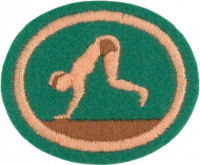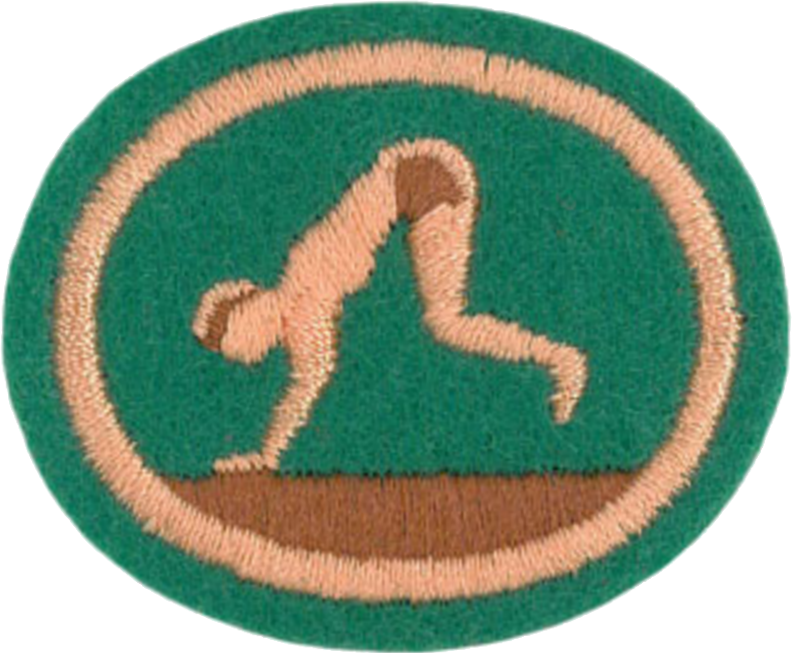Difference between revisions of "AY Honors/Tumbling & Balancing/Answer Key/es"
From Pathfinder Wiki
< AY Honors | Tumbling & BalancingAY Honors/Tumbling & Balancing/Answer Key/es
(Created page with "Especialidades JA/Gimnasia/Respuestas") |
(Updating to match new version of source page) |
||
| (33 intermediate revisions by one other user not shown) | |||
| Line 1: | Line 1: | ||
| − | + | {{HonorSubpage}} | |
| − | |||
| − | {{ | ||
| − | |||
| − | |||
| − | |||
| − | |||
| − | |||
| − | |||
| − | |||
<!--{{Honor_Master|honor=Tumbling & Balancing|master=Sportsman}}--> | <!--{{Honor_Master|honor=Tumbling & Balancing|master=Sportsman}}--> | ||
| − | |||
| − | |||
| − | |||
<section begin="Body" /> | <section begin="Body" /> | ||
{{ansreq|page={{#titleparts:{{PAGENAME}}|2|1}}|num=1}} | {{ansreq|page={{#titleparts:{{PAGENAME}}|2|1}}|num=1}} | ||
<noinclude></noinclude> | <noinclude></noinclude> | ||
| − | <!-- 1. | + | <!-- 1. Hacer una lista de precauciones de seguridad que cada ejecutante y espectador debe seguir. --> |
| − | |||
| − | + | {{clear}} | |
| − | |||
| − | |||
| − | |||
| − | |||
<noinclude></noinclude> | <noinclude></noinclude> | ||
| Line 29: | Line 12: | ||
{{ansreq|page={{#titleparts:{{PAGENAME}}|2|1}}|num=2}} | {{ansreq|page={{#titleparts:{{PAGENAME}}|2|1}}|num=2}} | ||
<noinclude></noinclude> | <noinclude></noinclude> | ||
| − | <!-- 2. | + | <!-- 2. Describir las posiciones básicas: --> |
<noinclude></noinclude> | <noinclude></noinclude> | ||
{{ansreq|page={{#titleparts:{{PAGENAME}}|2|1}}|num=2a}} | {{ansreq|page={{#titleparts:{{PAGENAME}}|2|1}}|num=2a}} | ||
<noinclude></noinclude> | <noinclude></noinclude> | ||
| − | |||
<noinclude></noinclude> | <noinclude></noinclude> | ||
| Line 39: | Line 21: | ||
{{ansreq|page={{#titleparts:{{PAGENAME}}|2|1}}|num=2b}} <!--T:5--> | {{ansreq|page={{#titleparts:{{PAGENAME}}|2|1}}|num=2b}} <!--T:5--> | ||
<noinclude></noinclude> | <noinclude></noinclude> | ||
| − | |||
<noinclude></noinclude> | <noinclude></noinclude> | ||
| Line 45: | Line 26: | ||
{{ansreq|page={{#titleparts:{{PAGENAME}}|2|1}}|num=2c}} <!--T:6--> | {{ansreq|page={{#titleparts:{{PAGENAME}}|2|1}}|num=2c}} <!--T:6--> | ||
<noinclude></noinclude> | <noinclude></noinclude> | ||
| − | |||
<noinclude></noinclude> | <noinclude></noinclude> | ||
| Line 51: | Line 31: | ||
{{ansreq|page={{#titleparts:{{PAGENAME}}|2|1}}|num=2d}} <!--T:7--> | {{ansreq|page={{#titleparts:{{PAGENAME}}|2|1}}|num=2d}} <!--T:7--> | ||
<noinclude></noinclude> | <noinclude></noinclude> | ||
| − | |||
<noinclude></noinclude> | <noinclude></noinclude> | ||
| Line 57: | Line 36: | ||
{{ansreq|page={{#titleparts:{{PAGENAME}}|2|1}}|num=2e}} <!--T:8--> | {{ansreq|page={{#titleparts:{{PAGENAME}}|2|1}}|num=2e}} <!--T:8--> | ||
<noinclude></noinclude> | <noinclude></noinclude> | ||
| − | |||
<noinclude></noinclude> | <noinclude></noinclude> | ||
| Line 63: | Line 41: | ||
{{ansreq|page={{#titleparts:{{PAGENAME}}|2|1}}|num=2f}} <!--T:9--> | {{ansreq|page={{#titleparts:{{PAGENAME}}|2|1}}|num=2f}} <!--T:9--> | ||
<noinclude></noinclude> | <noinclude></noinclude> | ||
| − | |||
<noinclude></noinclude> | <noinclude></noinclude> | ||
| Line 75: | Line 52: | ||
{{ansreq|page={{#titleparts:{{PAGENAME}}|2|1}}|num=3}} | {{ansreq|page={{#titleparts:{{PAGENAME}}|2|1}}|num=3}} | ||
<noinclude></noinclude> | <noinclude></noinclude> | ||
| − | <!-- 3. | + | <!-- 3. Realizar los siguientes maniobras individuales con forma y compostura: --> |
<noinclude></noinclude> | <noinclude></noinclude> | ||
{{ansreq|page={{#titleparts:{{PAGENAME}}|2|1}}|num=3a}} | {{ansreq|page={{#titleparts:{{PAGENAME}}|2|1}}|num=3a}} | ||
<noinclude></noinclude> | <noinclude></noinclude> | ||
| − | |||
<noinclude></noinclude> | <noinclude></noinclude> | ||
{{CloseReq}} <!-- 3a --> | {{CloseReq}} <!-- 3a --> | ||
{{ansreq|page={{#titleparts:{{PAGENAME}}|2|1}}|num=3b}} <!--T:12--> | {{ansreq|page={{#titleparts:{{PAGENAME}}|2|1}}|num=3b}} <!--T:12--> | ||
| − | <noinclude></noinclude> | + | <noinclude></noinclude><noinclude></noinclude> |
| − | <noinclude></noinclude> | ||
{{CloseReq}} <!-- 3b --> | {{CloseReq}} <!-- 3b --> | ||
{{ansreq|page={{#titleparts:{{PAGENAME}}|2|1}}|num=3c}} | {{ansreq|page={{#titleparts:{{PAGENAME}}|2|1}}|num=3c}} | ||
| − | <noinclude></noinclude> | + | <noinclude></noinclude><noinclude></noinclude> |
| − | <noinclude></noinclude> | ||
{{CloseReq}} <!-- 3c --> | {{CloseReq}} <!-- 3c --> | ||
{{ansreq|page={{#titleparts:{{PAGENAME}}|2|1}}|num=3d}} | {{ansreq|page={{#titleparts:{{PAGENAME}}|2|1}}|num=3d}} | ||
| − | <noinclude></noinclude> | + | <noinclude></noinclude><noinclude></noinclude> |
| − | <noinclude></noinclude> | ||
{{CloseReq}} <!-- 3d --> | {{CloseReq}} <!-- 3d --> | ||
{{ansreq|page={{#titleparts:{{PAGENAME}}|2|1}}|num=3e}} | {{ansreq|page={{#titleparts:{{PAGENAME}}|2|1}}|num=3e}} | ||
| − | <noinclude></noinclude> | + | <noinclude></noinclude><noinclude></noinclude> |
| − | <noinclude></noinclude> | ||
{{CloseReq}} <!-- 3e --> | {{CloseReq}} <!-- 3e --> | ||
{{ansreq|page={{#titleparts:{{PAGENAME}}|2|1}}|num=3f}} | {{ansreq|page={{#titleparts:{{PAGENAME}}|2|1}}|num=3f}} | ||
<noinclude></noinclude> | <noinclude></noinclude> | ||
| − | |||
<noinclude></noinclude> | <noinclude></noinclude> | ||
| Line 107: | Line 78: | ||
{{ansreq|page={{#titleparts:{{PAGENAME}}|2|1}}|num=3g}} <!--T:13--> | {{ansreq|page={{#titleparts:{{PAGENAME}}|2|1}}|num=3g}} <!--T:13--> | ||
<noinclude></noinclude> | <noinclude></noinclude> | ||
| − | |||
<noinclude></noinclude> | <noinclude></noinclude> | ||
| Line 113: | Line 83: | ||
{{ansreq|page={{#titleparts:{{PAGENAME}}|2|1}}|num=3h}} <!--T:14--> | {{ansreq|page={{#titleparts:{{PAGENAME}}|2|1}}|num=3h}} <!--T:14--> | ||
<noinclude></noinclude> | <noinclude></noinclude> | ||
| − | |||
<noinclude></noinclude> | <noinclude></noinclude> | ||
| Line 119: | Line 88: | ||
{{ansreq|page={{#titleparts:{{PAGENAME}}|2|1}}|num=3i}} <!--T:15--> | {{ansreq|page={{#titleparts:{{PAGENAME}}|2|1}}|num=3i}} <!--T:15--> | ||
<noinclude></noinclude> | <noinclude></noinclude> | ||
| − | |||
<noinclude></noinclude> | <noinclude></noinclude> | ||
| Line 125: | Line 93: | ||
{{ansreq|page={{#titleparts:{{PAGENAME}}|2|1}}|num=3j}} <!--T:16--> | {{ansreq|page={{#titleparts:{{PAGENAME}}|2|1}}|num=3j}} <!--T:16--> | ||
<noinclude></noinclude> | <noinclude></noinclude> | ||
| − | |||
<noinclude></noinclude> | <noinclude></noinclude> | ||
| Line 131: | Line 98: | ||
{{ansreq|page={{#titleparts:{{PAGENAME}}|2|1}}|num=3k}} <!--T:17--> | {{ansreq|page={{#titleparts:{{PAGENAME}}|2|1}}|num=3k}} <!--T:17--> | ||
<noinclude></noinclude> | <noinclude></noinclude> | ||
| − | |||
<noinclude></noinclude> | <noinclude></noinclude> | ||
| Line 137: | Line 103: | ||
{{ansreq|page={{#titleparts:{{PAGENAME}}|2|1}}|num=3l}} <!--T:18--> | {{ansreq|page={{#titleparts:{{PAGENAME}}|2|1}}|num=3l}} <!--T:18--> | ||
<noinclude></noinclude> | <noinclude></noinclude> | ||
| − | |||
<noinclude></noinclude> | <noinclude></noinclude> | ||
| Line 143: | Line 108: | ||
{{CloseReq}} <!-- 3 --> | {{CloseReq}} <!-- 3 --> | ||
{{ansreq|page={{#titleparts:{{PAGENAME}}|2|1}}|num=4}} | {{ansreq|page={{#titleparts:{{PAGENAME}}|2|1}}|num=4}} | ||
| − | <noinclude></noinclude> | + | <noinclude></noinclude><noinclude></noinclude> |
| − | |||
| − | <noinclude></noinclude> | ||
{{ansreq|page={{#titleparts:{{PAGENAME}}|2|1}}|num=4a}} | {{ansreq|page={{#titleparts:{{PAGENAME}}|2|1}}|num=4a}} | ||
<noinclude></noinclude> | <noinclude></noinclude> | ||
| − | |||
<noinclude></noinclude> | <noinclude></noinclude> | ||
| Line 154: | Line 116: | ||
{{ansreq|page={{#titleparts:{{PAGENAME}}|2|1}}|num=4b}} <!--T:20--> | {{ansreq|page={{#titleparts:{{PAGENAME}}|2|1}}|num=4b}} <!--T:20--> | ||
<noinclude></noinclude> | <noinclude></noinclude> | ||
| − | |||
| − | |||
| − | |||
| − | |||
| − | |||
<noinclude></noinclude> | <noinclude></noinclude> | ||
| Line 164: | Line 121: | ||
{{ansreq|page={{#titleparts:{{PAGENAME}}|2|1}}|num=4c}} <!--T:21--> | {{ansreq|page={{#titleparts:{{PAGENAME}}|2|1}}|num=4c}} <!--T:21--> | ||
<noinclude></noinclude> | <noinclude></noinclude> | ||
| − | |||
<noinclude></noinclude> | <noinclude></noinclude> | ||
{{CloseReq}} <!-- 4c --> | {{CloseReq}} <!-- 4c --> | ||
{{ansreq|page={{#titleparts:{{PAGENAME}}|2|1}}|num=4d}} <!--T:22--> | {{ansreq|page={{#titleparts:{{PAGENAME}}|2|1}}|num=4d}} <!--T:22--> | ||
| − | <noinclude></noinclude> | + | <noinclude></noinclude><noinclude></noinclude> |
| − | <noinclude></noinclude> | ||
{{CloseReq}} <!-- 4d --> | {{CloseReq}} <!-- 4d --> | ||
{{ansreq|page={{#titleparts:{{PAGENAME}}|2|1}}|num=4e}} | {{ansreq|page={{#titleparts:{{PAGENAME}}|2|1}}|num=4e}} | ||
| − | <noinclude></noinclude> | + | <noinclude></noinclude><noinclude></noinclude> |
| − | <noinclude></noinclude> | ||
{{CloseReq}} <!-- 4e --> | {{CloseReq}} <!-- 4e --> | ||
{{ansreq|page={{#titleparts:{{PAGENAME}}|2|1}}|num=4f}} | {{ansreq|page={{#titleparts:{{PAGENAME}}|2|1}}|num=4f}} | ||
| − | <noinclude></noinclude> | + | <noinclude></noinclude><noinclude></noinclude> |
| − | <noinclude></noinclude> | ||
{{CloseReq}} <!-- 4f --> | {{CloseReq}} <!-- 4f --> | ||
{{ansreq|page={{#titleparts:{{PAGENAME}}|2|1}}|num=4g}} | {{ansreq|page={{#titleparts:{{PAGENAME}}|2|1}}|num=4g}} | ||
| − | <noinclude></noinclude> | + | <noinclude></noinclude><noinclude></noinclude> |
| − | <noinclude></noinclude> | ||
{{CloseReq}} <!-- 4g --> | {{CloseReq}} <!-- 4g --> | ||
{{ansreq|page={{#titleparts:{{PAGENAME}}|2|1}}|num=4h}} | {{ansreq|page={{#titleparts:{{PAGENAME}}|2|1}}|num=4h}} | ||
<noinclude></noinclude> | <noinclude></noinclude> | ||
| − | + | {{clear}} | |
<noinclude></noinclude> | <noinclude></noinclude> | ||
| Line 193: | Line 145: | ||
{{CloseReq}} <!-- 4 --> | {{CloseReq}} <!-- 4 --> | ||
<noinclude></noinclude> | <noinclude></noinclude> | ||
| − | == | + | ==Referencias== |
<noinclude></noinclude> | <noinclude></noinclude> | ||
| − | + | {{CloseHonorPage}} | |
| − | |||
Latest revision as of 21:26, 14 July 2022
1
Hacer una lista de precauciones de seguridad que cada ejecutante y espectador debe seguir.
2
Describir las posiciones básicas:
2a
Agrupado
2b
Escuadra
2c
Extendido
2d
Híper extensión (arco)
2e
En cuclillas
2f
Abrirse de piernas
2g
Posición de pie (ampliación)
3
Realizar los siguientes maniobras individuales con forma y compostura:
3a
Rodar en la posición de agrupado desde cuclillas hacia adelante
3b
Rodar a la posición de escuadra desde la posición de pie
3c
Rodar y clavarse (la longitud debe ser igual a la altura propia)
3d
Rodar en la posición de agrupado desde cuclillas hacia atrás
3e
Rodar hacia atrás desde la posición de pie
3f
Rodar hacia atrás al abrir las piernas desde la posición extendido
3g
Caída sueco
3h
Posición de rana (pegando la rodilla y el codo apoyado)
3i
Parada de cabeza desde la posición de rana
3j
Parada de mano con la cabeza apoyada
3k
Parada de manos sin la cabeza apoyada
3l
Hacer una voltereta lateral (cartwheel)
4
Realizar con forma y compostura seis de las siguientes maniobras con un compañero:
4a
Posición en pecho
4b
Posición en muslo
4c
Equilibrio de rodilla sobre los hombros
4d
Equilibrio del ángel de frente
4e
Parada en los hombros
4f
Apoyar en la rodilla baja
4g
Equilibrio en el muslo
4h
El ángel de frente, abierto de piernas en la cintura


